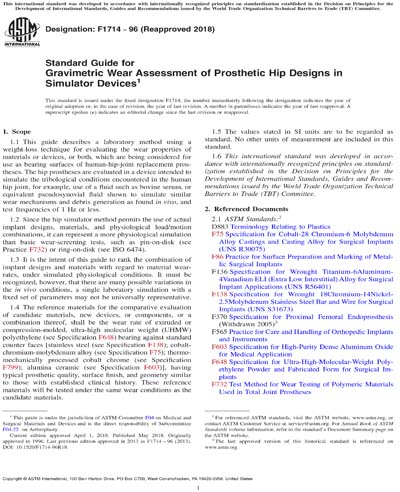Most recent
ASTM F1714-96(2018)
Standard Guide for Gravimetric Wear Assessment of Prosthetic Hip Designs in Simulator Devices
1.1 This guide describes a laboratory method using a weight-loss technique for evaluating the wear properties of materials or devices, or both, which are being considered for use as bearing surfaces of human-hip-joint replacement prostheses. The hip prostheses are evaluated in a device intended to simulate the tribological conditions encountered in the human hip joint, for example, use of a fluid such as bovine serum, or equivalent pseudosynovial fluid shown to simulate similar wear mechanisms and debris generation as found in vivo, and test frequencies of 1 Hz or less.
1.2 Since the hip simulator method permits the use of actual implant designs, materials, and physiological load/motion combinations, it can represent a more physiological simulation than basic wear-screening tests, such as pin-on-disk (see Practice F732) or ring-on-disk (see ISO 6474).
1.3 It is the intent of this guide to rank the combination of implant designs and materials with regard to material wear-rates, under simulated physiological conditions. It must be recognized, however, that there are many possible variations in the in vivo conditions, a single laboratory simulation with a fixed set of parameters may not be universally representative.
1.4 The reference materials for the comparative evaluation of candidate materials, new devices, or components, or a combination thereof, shall be the wear rate of extruded or compression-molded, ultra-high molecular weight (UHMW) polyethylene (see Specification F648) bearing against standard counter faces [stainless steel (see Specification F138); cobalt-chromium-molybdenum alloy (see Specification F75); thermomechanically processed cobalt chrome (see Specification F799); alumina ceramic (see Specification F603)], having typical prosthetic quality, surface finish, and geometry similar to those with established clinical history. These reference materials will be tested under the same wear conditions as the candidate materials.
1.5 The values stated in SI units are to be regarded as standard. No other units of measurement are included in this standard.
1.6 This international standard was developed in accordance with internationally recognized principles on standardization established in the Decision on Principles for the Development of International Standards, Guides and Recommendations issued by the World Trade Organization Technical Barriers to Trade (TBT) Committee.
Content Provider
ASTM International [astm]






